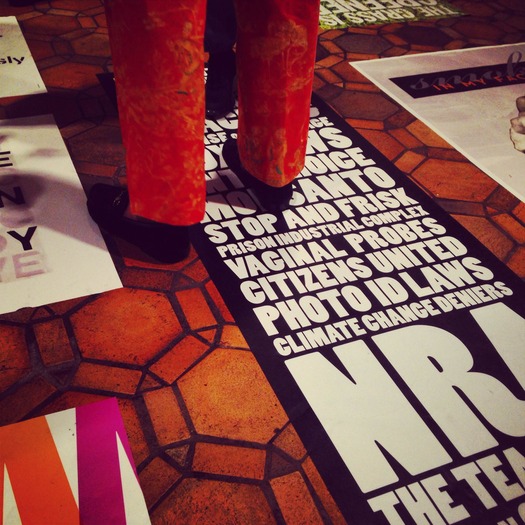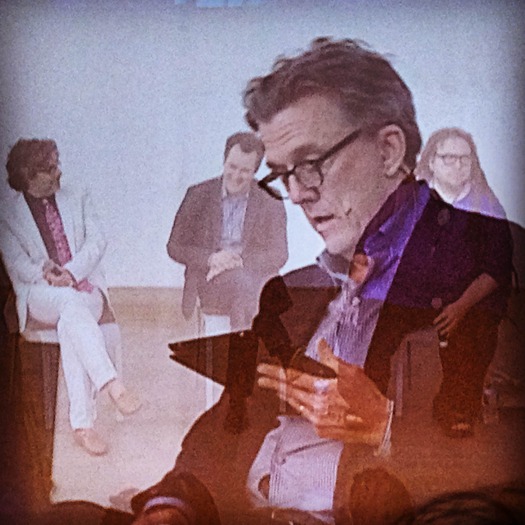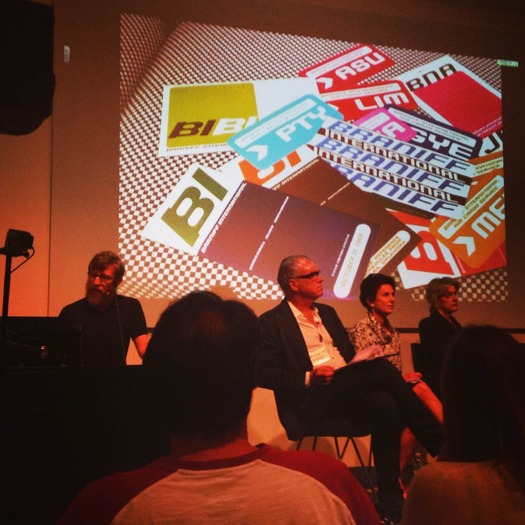
The poster exhibit at the "Power of Design". All photos by Samantha Garcia.
Steven Heller kicked off the inaugural "Power of Design" ideas festival in Miami Beach at an altar of Art Deco palm fronds. MC’ed by inimitable writer Kurt Andersen, this year’s festival theme was “Complaints.” Participants had the mandate to drive “dissatisfaction to action” and “action to innovation” over four days at the Wolfsonian Museum.
Heller opened his curated poster exhibit Complaints: An Inalienable Right with the rollicking sounds of the Florida International University Complaints Choir. Scolding sopranos jostled the surprised crowd, belting about #firstworldproblems such as sweat and loud talking.
Addressing discomfort — “whether physical, functional, or aesthetic,” per festival decree — required that the poster designers slyly acknowledge an operating premise of comfort. Sean Adams’ twee, rose-hued “What I Hate” wisely kvetched about ladies “whining on the yacht.” Also on the walls was evidence of self-deprecation (J.J. Sedelmeier’s 1990s-grunge “Bitchin’ Poster”; Emily Oberman’s sassy and undulant “World’s Smallest Violin”) and topical subtlety (“Crumble,” a gentrification Tetris by Oliver Munday).
But many more responded to their brief with heavy-hitting protest set in high contrast. Hipster hit pieces ceded awkwardly to earnest collective petitioning. Targets of ire included everything from the Trayvon Martin verdict and Kurdish genocide (Chaz Maviyane-Davies' "Still Loading"; Majid Abbasi’s “Lacrimosa”) to gender clichés (Jennifer Kenon’s “Act Like A Lady”) — the latter sentiment, I must complain, applicable to only 25% of featured speakers.

Emcee Kurt Anderson with Michael Chabon, Clive Thompson and Jaron Lanier
The dichotomy between privilege and agitation neatly fits the Wolfsonian, a sleekly produced museum housed inside a 1926 Spanish Renaissance-style sandstone with a collection rooted in decorative and propaganda art from 1885 to 1945. Its staid upper galleries, connected by Wharton Esherick’s swirling pine wood stair, contain predominantly European and American works selected to illuminate motifs of rapid change and reactionary reform. A current exhibit, Echoes and Origins, interrogates eerily pretty Futurist ceramics among other agitprop artifacts of Italian interwar design.
Upstairs from Inalienable Right was multidisciplinary designer Todd Oldham’s “BUMMER,” a tongue-in-cheek critique of the museum’s sometimes Debbie Downer focal period. From Great Depression slum wedding paintings to Hitler’s gleaming silverware, Oldham’s kitschy outsider touch liberated this assemblage from wincing Charles Krafft territory. Other funny gripes came from humorist Andy Borowitz (The New Yorker), who led a deadpan safari of Twitter as satirical platform. Belly laughs of sympathy came from an audience sick of “microaggressions” from comment-jockeying haters and trolls.

Todd Oldham presents on Alexander Girard flanked by Alastair Gordon, Nancy Novogrod and Dickie Davis
That evening, a panel of "digital prophets” argued (somewhat belatedly) about the life-stealing properties of the internet inside the Pérez Art Museum Miami on lush Biscayne Bay. Computer science pioneer Jaron Lanier dominated the debate over author Michael Chabon and reporter Clive Thompson, making delicate rebuttals to his companions’ respective analog nostalgia and aggressive solutionism. His complaint was more a lament for early financial algorithms that used an “almost Zen-like method to total domination” to gradually build the current imbalance of global capital.
Online discourse was second only to urban life as the most popular subject of everyday grief. Absolutely no one from out of town complained about being in Miami between Art Basel and the ADC Festival. But local attendees to a “Cities and City Life” panel cited the severe growing pains that have accompanied amazing feats of adaptive reuse in their South Beach historic district.
“Complaint is expressed as social time bomb,” observed Chilean architect Alejandro Aravena, whose social housing work adds appreciation value to promote quality of life for the poor. “Instead of trying to dismantle the bomb, design should try to channel its energy." New Urbanism iconoclast Andrés Duany agreed, advocating swift escalation to action while trashing “glacial” bureaucracies.

Collins Ave, Miami
The next whine? Transit, perhaps the biggest bête noir of traffic-ridden Miami.
“When the cars own the street, they misbehave,” asserted American alternative transport pop-wonk Gabe Klein. Brainstorming cross-talk was caught by ear mics. Classic conference format nearly broke into full charrette as the group reached rapid consensus over tactical urbanism.
“The car is the cigarette of the future,” proclaimed Brazilian politician and urban planner Jaime Lerner, waving a model prototype of a paper-and-resin ultra-smart car. As mayor of Curitiba in the 1970s, Lerner led the invention of Bus Rapid Transit, a solution to congestion now adopted in over 166 cities worldwide. Lerner advised approaching an entrenched culture of complaint — “they can have orgasms if you say there’s no solution” — with a trust-based process of “urban acupuncture,” initiating gestural local interventions that gradually yield to a sequential design process.
A chat on the universally lamentable experience of air travel began with journalist Alastair Gordon presenting on the designed airport as symbol of (to paraphrase Barthes) an excess of speed converted into repose. Oldham then recalled a soothing 1960s utopia of stylish, comfortable commercial flying, plundering the archives of Alexander Girard’s designs for Braniff Airways. Bannered boarding passes, tangy cabin fabric swatches and “very lovely” bright pink barf bags all incited yearning for a time of ample leg room. But aesthetics dominated the session to a fault; while IDEO’s empathy work with TSA agents was briefly glossed, more consideration was given to today’s aeroponic gardens (at Chicago O’Hare) and soothing womb chairs (at Helsinki-Vantaa, after Eero Saarinen) than to grievances over profiling.
Despite the spread of “change-makers, thought leaders, innovators” assembled, Power of Design was most successful in its informal conversations. Though logistics were superb, there were some curatorial lapses: a public Complaints Booth was sidelined indoors, the watchdog journalism session had the worst spot on the schedule, and a traffic solution exhibit by Florida International University architecture and design students was offsite. But in the absence of elite critique, participants sorted out their own answers to the question of innovation for whom, by whom. Borrowing a relational aesthetics chess move, attendees took over the sidewalk facing Washington Avenue with tables and chairs, asserting a conversational pedestrian oasis amid speeding trucks and tourist Segways.
Power of Design showed that designers concerned with innovation would be well served to take cues and critiques from every valence of experience. Design has the potential to become “the last refuge of solidarity," to borrow from Jaime Lerner’s thoughts on the contemporary city. It will be a delight to watch the conference mature on these topics as it grows in rigor and scope. In the meantime, Lerner had a quick solution for those tastemakers who only love to grouse:
“We should beat them with slippers!”


